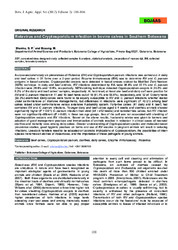| dc.contributor.author | Sharma, S.P. | |
| dc.contributor.author | Busang., M. | |
| dc.date.accessioned | 2019-09-24T13:20:55Z | |
| dc.date.accessioned | 2021-03-15T08:57:31Z | |
| dc.date.available | 2019-09-24T13:20:55Z | |
| dc.date.available | 2021-03-15T08:57:31Z | |
| dc.date.issued | 2012 | |
| dc.identifier.citation | Sharma and Busang (2012) Rotavirus and Cryptosporidium infection in bovine calves. Bots. J. Agric. Appl. Sci. (2012) 8 (Issue 2) 101-106 | en_US |
| dc.identifier.issn | 1815-5574 | |
| dc.identifier.uri | http://moodle.buan.ac.bw:80/handle/123456789/194 | |
| dc.description | Journal article | en_US |
| dc.description.abstract | A cross-sectional study on prevalences of Rotavirus (RV) and Cryptosporidium parvum infections was carried out in dairy and beef calves in 31 farms over a 2-year period. Enzyme immunoassay (EIA) was to determine RV and C. parvum antigens in faecal samples. Cryptosporidial oocysts were detected in faecal smears stained by Modified Ziehl-Neelsen (MZN) technique. In dairy and beef animals, RV infections determined by EIA were 38.4% and 22.1% and C. parvum infection were 28.8% and 15.8%, respectively. MZN staining technique detected Cryptosporidium oocysts in 24.5% and 9.2% of the dairy and beef calves’ samples, respectively. At herd level, at least one beef and dairy calf were positive for RV and C. parvum infection in 11 and 10 beef herds out of 18 (61.1% and 55.6%), respectively, and 12 of 13 dairy herds (92.3%) examined. Dairy calves were found to be equally susceptible to RV and C. parvum infections whether reared under semi-intensive or intensive managements, but differences in infections were significant (P <0.01) among beef calves raised under semi-intensive versus extensive husbandry system. Forty-five calves (41 dairy and 4 beef) had combined RV and C. parvum infections. Younger dairy and beef calves aged 4 weeks and diarrheic animals showed significantly higher (P < 0.01) C. parvum infection than older ( 4 - 12 weeks) and non-diarrheic calves, but RV infection were not significantly different (P > 0.05) in these two age groups. Sex of the calf was not associated with shedding of Cryptosporidium oocysts and RV infections. Based on the above results, husbandry advice was given to farmers and adoption of good management practices and immunization of animals resulted in reduction in clinical cases of neonatal diarrhea and mortality rates among dairy calves. Greater understanding of Cryptosporidium species and molecular-based prevalence studies, good hygienic practices on farms and use of RV vaccine in pregnant animals will result in reducing infections. Livestock handlers need to be educated on zoonotic implications of Cryptosporidium, the possibilities of interspecies transmission abilities of Rotaviruses, and the importance of these pathogens in young animals. | en_US |
| dc.description.sponsorship | BUAN | en_US |
| dc.language.iso | en | en_US |
| dc.publisher | Botswana University of Agriculture and Natural resources | en_US |
| dc.relation.ispartofseries | Botswana Journal of Agriculture and Applied Sciences;Vol. 8 (Issue 2): 101-106 | |
| dc.subject | Beef calves | en_US |
| dc.subject | Cryptosporidium parvum | en_US |
| dc.subject | Diarrhea | en_US |
| dc.subject | Dairy calves | en_US |
| dc.subject | Enzyme immunoassay | en_US |
| dc.subject | Rotavirus | en_US |
| dc.title | Rotavirus and Cryptosporidium infection in bovine calves in Southern Botswana. | en_US |
| dc.type | Article | en_US |

